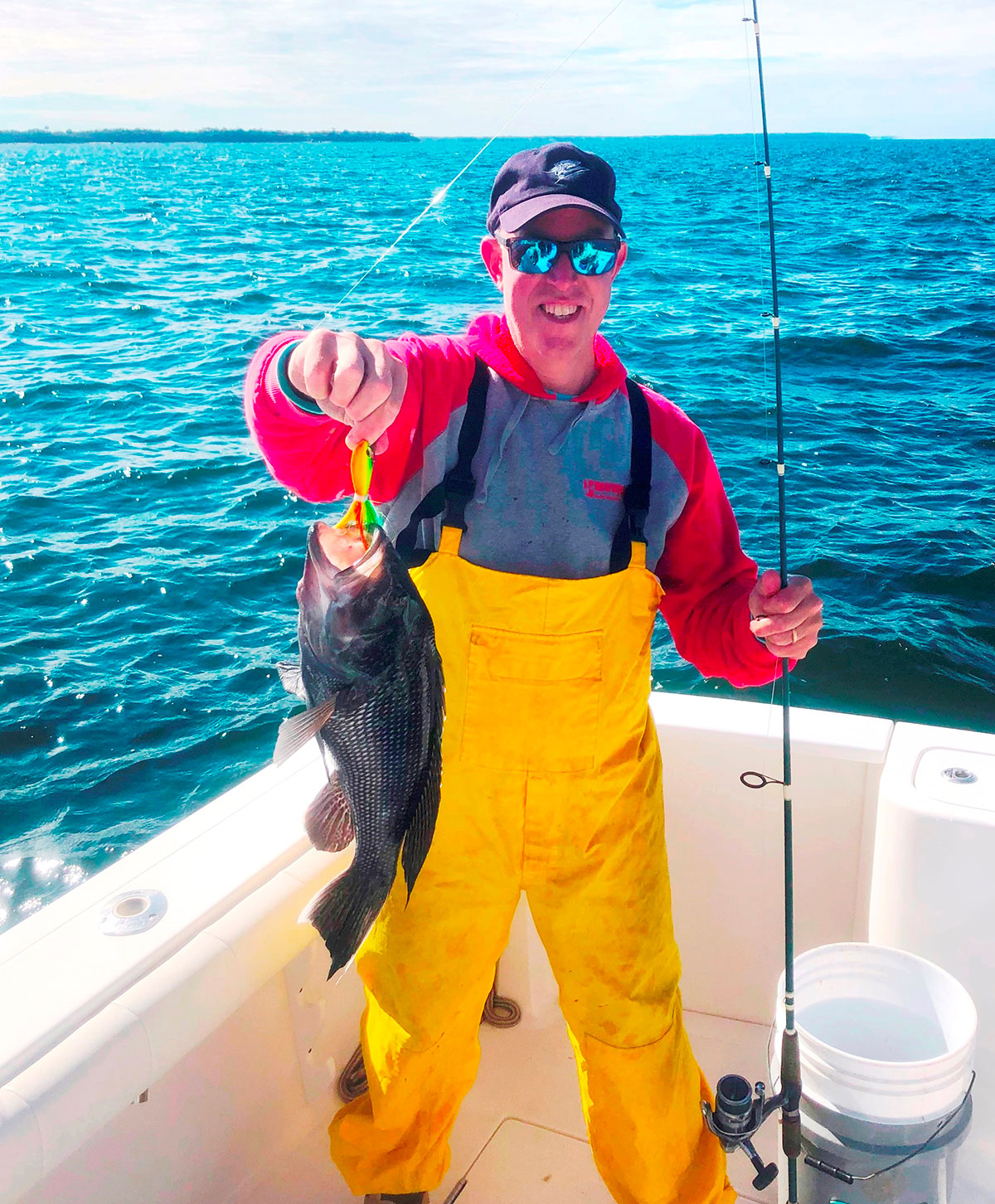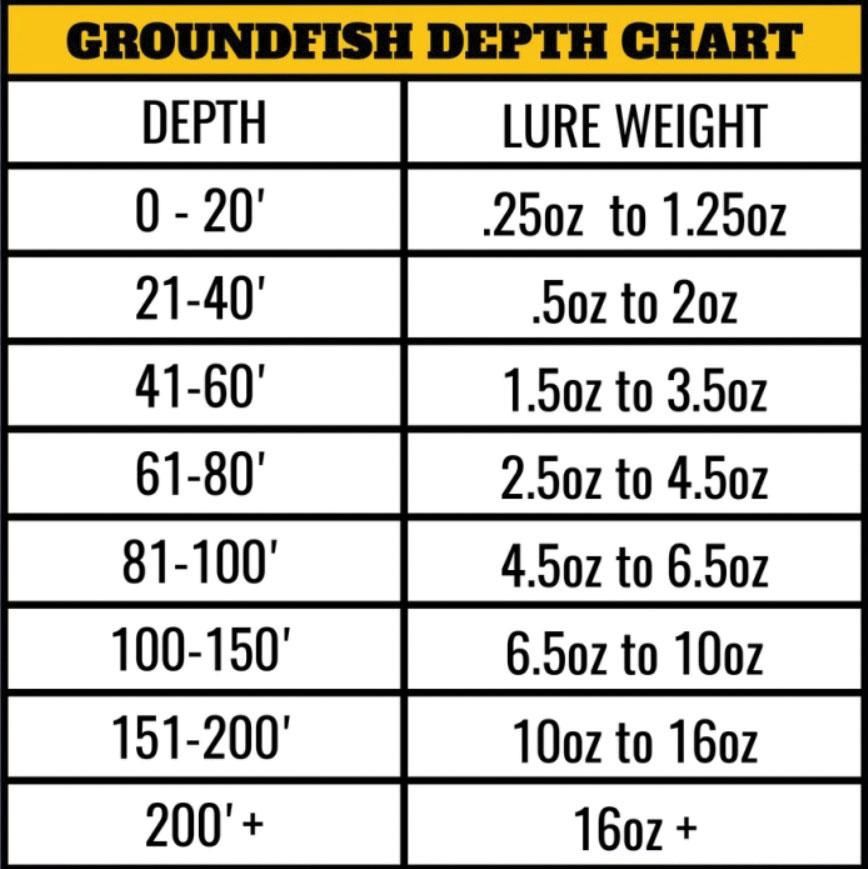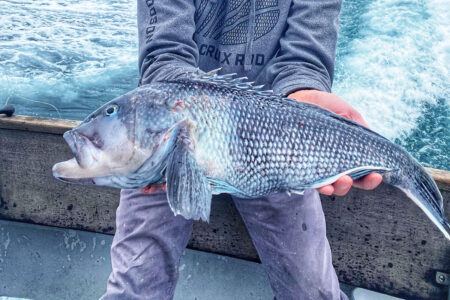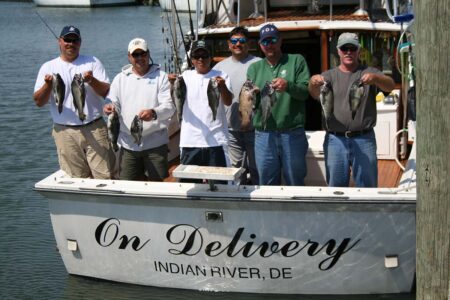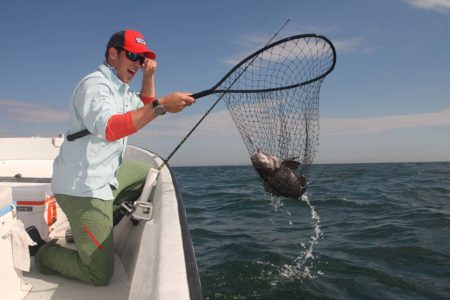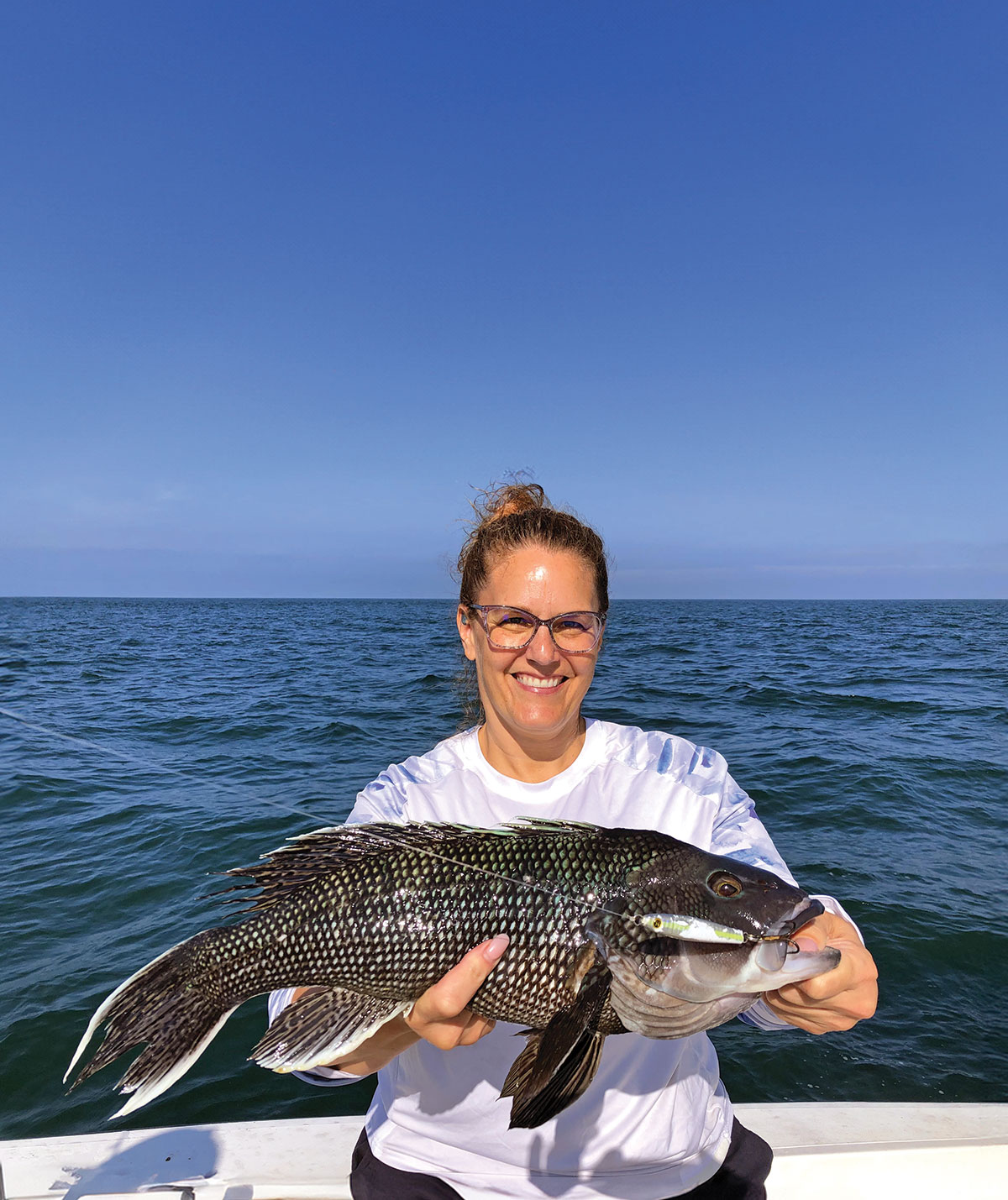
Get in with the black sea bass jigging gamers this season.
Few inshore and near offshore recreational fisheries from the DELMARVA coast, up off the Jersey Shore, to the north and south shores of Long Island, and east to Cape Cod can match the popularity of targeting black sea bass for your day’s piscatorial pursuits.
There are numerous methods to put sea bass in your cooler, but for this article, we’re going to focus on deepwater jigging, which we’ll describe as anything ranging from 65 to 180 feet of water.
Before we dive into specific techniques, equipment, and jig styles, let’s learn a little bit more about the black sea bass, thanks to the folks at NOAA Fisheries and the Massachusetts Division of Fisheries. As the name implies, their body coloration is blackish to grayish; however, the center of the scales is white. During the spawning season, dominant males turn bright blue colors and have a large hump on their heads. Juveniles are brown in color and have a dark lateral stripe running down the body.
Black sea bass can reach up to 25 inches or more in length and over 8 pounds in weight, although the majority of fish caught weigh less than 4 pounds. They are able to reproduce when they reach 1- to 3-years old, and as protogynous hermaphrodites most black sea bass start out as females and become males as they mature and grow. Researchers aren’t sure why this happens, but one hypothesis suggests the relative scarcity of males in a spawning group may be the stimulus for a female to switch sex.
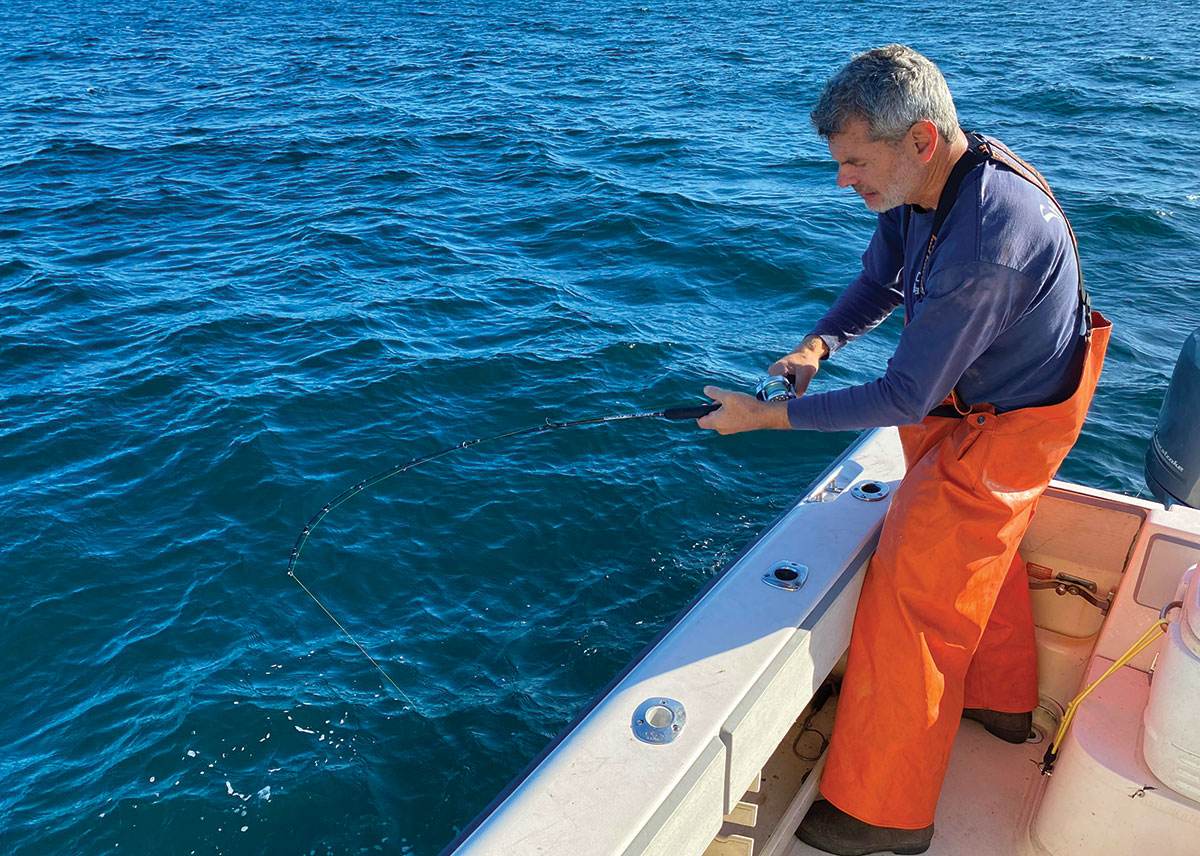
Range Finding
Black sea bass spawn in coastal areas from the spring to early summer months, depending on the specific water temps and location within their range. Males gather a group of females to mate with and aggressively defend their territory. Depending on their size, females can produce between 30,000 and 500,000 eggs in a spawning season. According to the Massachusetts Division of Marine Fisheries, sea bass eggs float in the water column for only a few days before hatching into larvae that then settle in nearshore waters. Young juveniles migrate to estuaries, where they grow and develop throughout the summer and early fall. Females can live up to 8 years, males to 12. Black sea bass eat whatever prey is available, but they especially like crabs, shrimp, worms, small fish, squid and clams. Skate, spiny dogfish, monkfish, spotted hake, and summer flounder all feed on juvenile black sea bass.
Along the Atlantic Coast, black sea bass are available in abundance from Cape Cod to the Gulf of Mexico. They are a migratory fish, wintering in deep water off the coast of the Mid-Atlantic states and traveling northward and inshore in the spring, generally arriving in large schools to Northeast waters sometime in May. Adult sea bass then take up residence over rocky bottoms or anywhere some structure can be found in depths of less than 150 feet.
They are abundant in Massachusetts waters until October, with the largest concentrations found in Buzzards Bay and Nantucket and Vineyard Sounds. Juvenile and young-of-the-year sea bass tend to prefer estuaries, where they feed on smaller fish and avoid predators. Moving south, there are large populations of black sea bass in the entirety of Long Island Sound’s rocky and wreck-strewn bottom bordering Connecticut and New York, with additional populations congregating on the majority of wrecks and artificial ocean reefs situated off Long Island, New Jersey, and Delaware coastal areas.
The rocky coast of Rhode Island, the areas around Montauk Point, Block Island Sound, and the rocky ledges around Block Island are some of the most prolific sea bass habitats in the Northeast. Most summer sea bass fishing in ocean areas is concentrated in waters from 65 to 135 feet around the structure, which is their preferred habitat for both foraging and protection from apex predators. As sea bass begin to migrate out of coastal areas in mid-October, it’s possible to “follow the migration” and catch them when they are heading offshore on wrecks from 150 to 210 feet and deeper, with cooperative, hungry sea bass bending rods until mid-December or later.
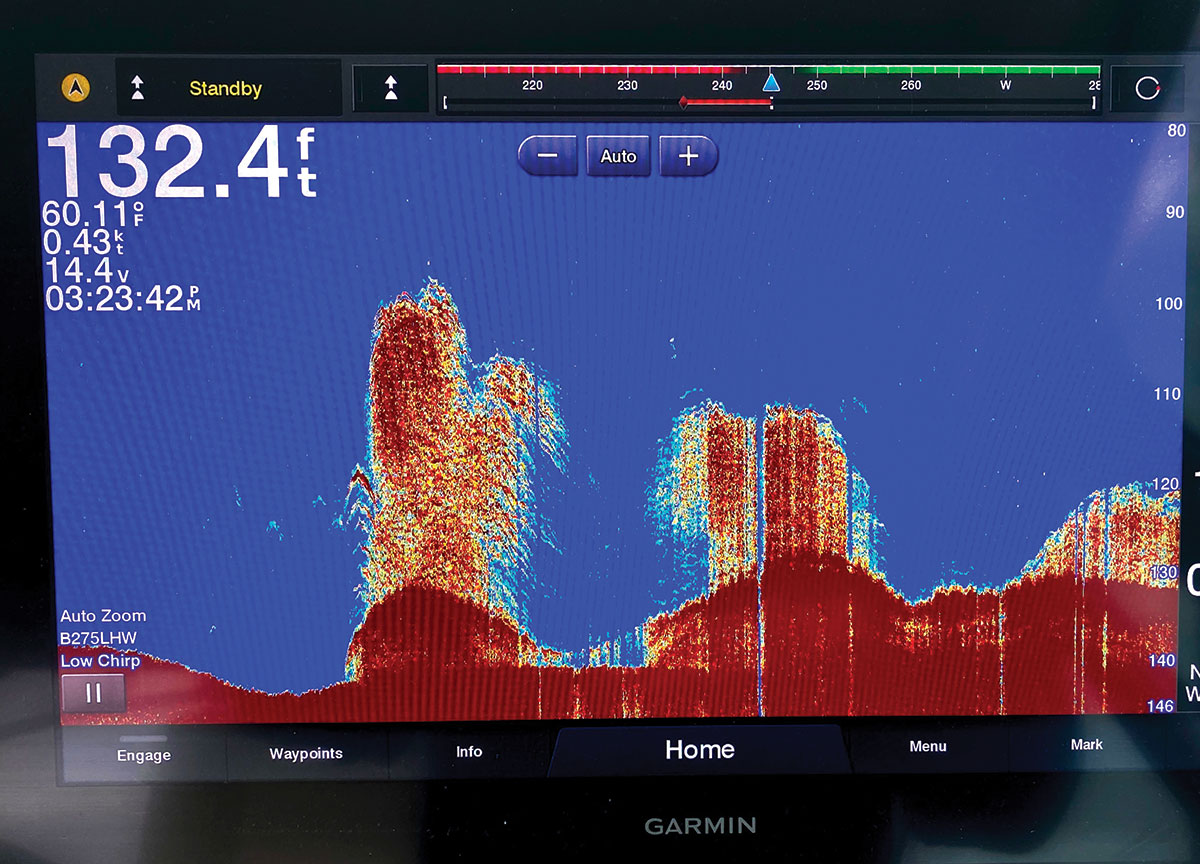
Structure Is Key
Suffice to say, the key to locating swarms of hungry sea bass is to focus on the structure that attracts them, both for forage opportunities and also protection from apex predators like sharks, bluefish and tuna that would relish the chance to make them a delicious meal. In my part of the world, I have fished wrecks and rock piles in the Long Island Sound from NYC’s Throggs Neck Bridge and east to Fisher’s Island, including the rocky underwater spine that connects Montauk to Block Island.
The most consistent sandy bottom ocean spots where I’ve caught numerous black sea bass over the decades are typically on the midrange and deepwater reefs and over the hundreds of wrecks that I keep close to the vest, ranging from the Rockaways and east to Montauk Point. Each one of these is practically a guarantee of sea bass action from June through November and the pieces with the least amount of traffic always give up the biggest and most numerous “sea-biscuits”.
For fast moving water like the 100-mile stretch of LI Sound, the waters off Buzzards Bay, Cape Cod, Block Island Sound, Montauk and Block Island, you usually have to pick your 3-hour spots preceding and following either slack high tide and/or slack low tide to keep your jigs on the bottom as vertical as possible, which enables you to have a better “feel” what’s happening as you work the depths.
In comparison, I’ve found that ocean waters can be a bit more forgiving when jigging, with slower-moving water that is frequently not as affected by tidal flow.
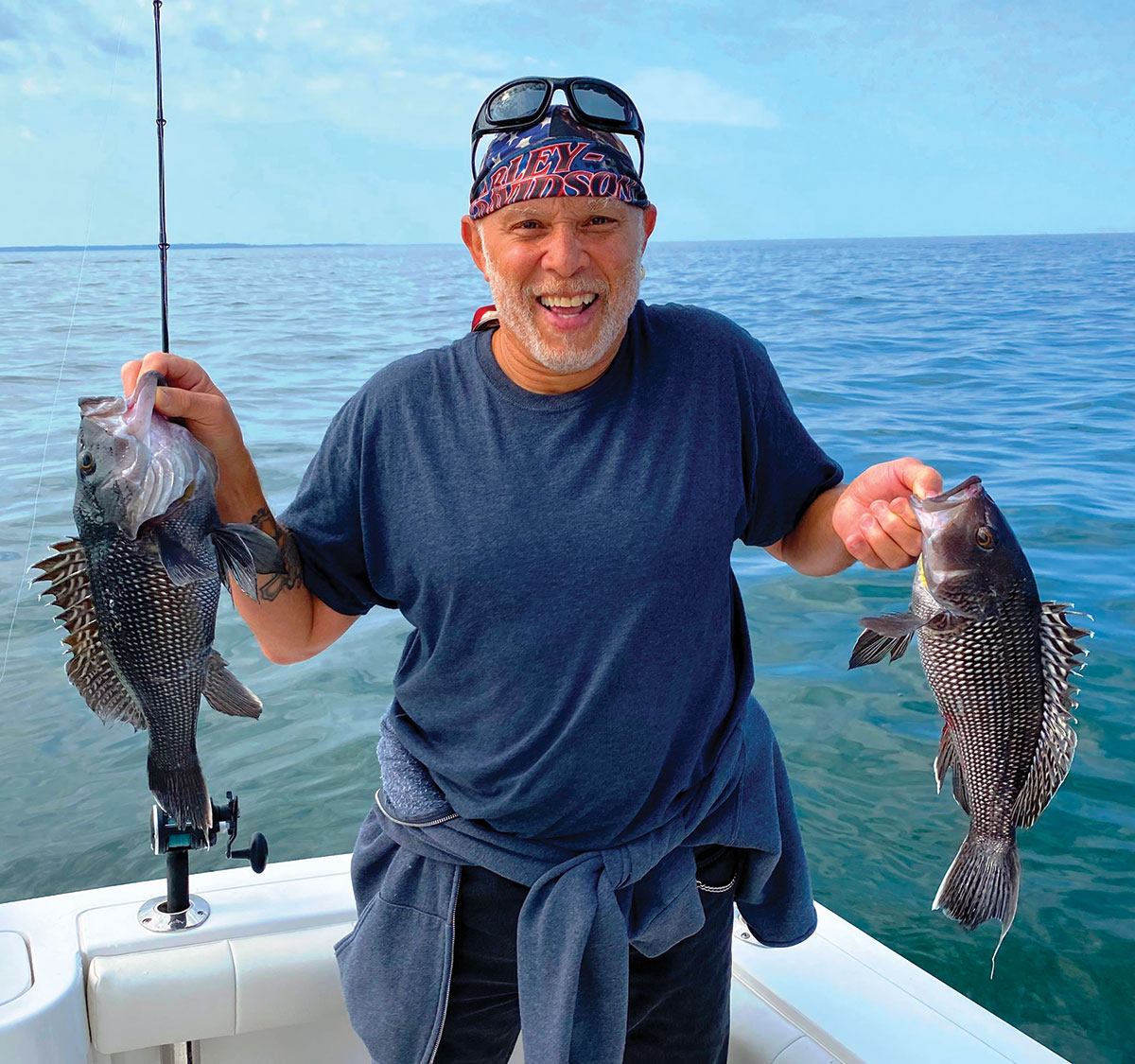
Drift Or Hold?
If you have installed an electric trolling motor on your boat, you might experience a more successful ability to “hold your spot” hovering over a wreck, reef, or other piece of structure, which gives your jig more vertical time in the target zone. However, I have observed numerous boats in recent years trying to “put a square peg in a round hole,” having their electric motors working overtime to hold fast with a 3- to 4-knot current running hard with the wind. What happens in this scenario is that the boat might hold its ground over a productive spot, but the jigs will not and are frequently swept 50 yards or more down current by the time they hit bottom, being out of the spot where the fish are being marked on your echo sounder. Another byproduct of this borderline technique for this scenario is creating a lot of dirty looks from neighboring boats and anglers as they are drifting by at 3 to 4 knots, trying to work their rigs near the bottom to catch fish and are now also trying to avoid hitting your “stationary object” as they slide by.
I’m a big fan of electric trolling motors, which can be a total game changer for many types of fisheries, including deep jigging for sea bass. They are a great addition to any fishing boat where they are sized correctly and matched to the boat’s weight and gunwale height to do the job. Just remember that one solution does not fit all challenges, and there are plusses and minuses for e-motors depending on the mission, sea state, current conditions, depth of water, and what you are trying to accomplish.
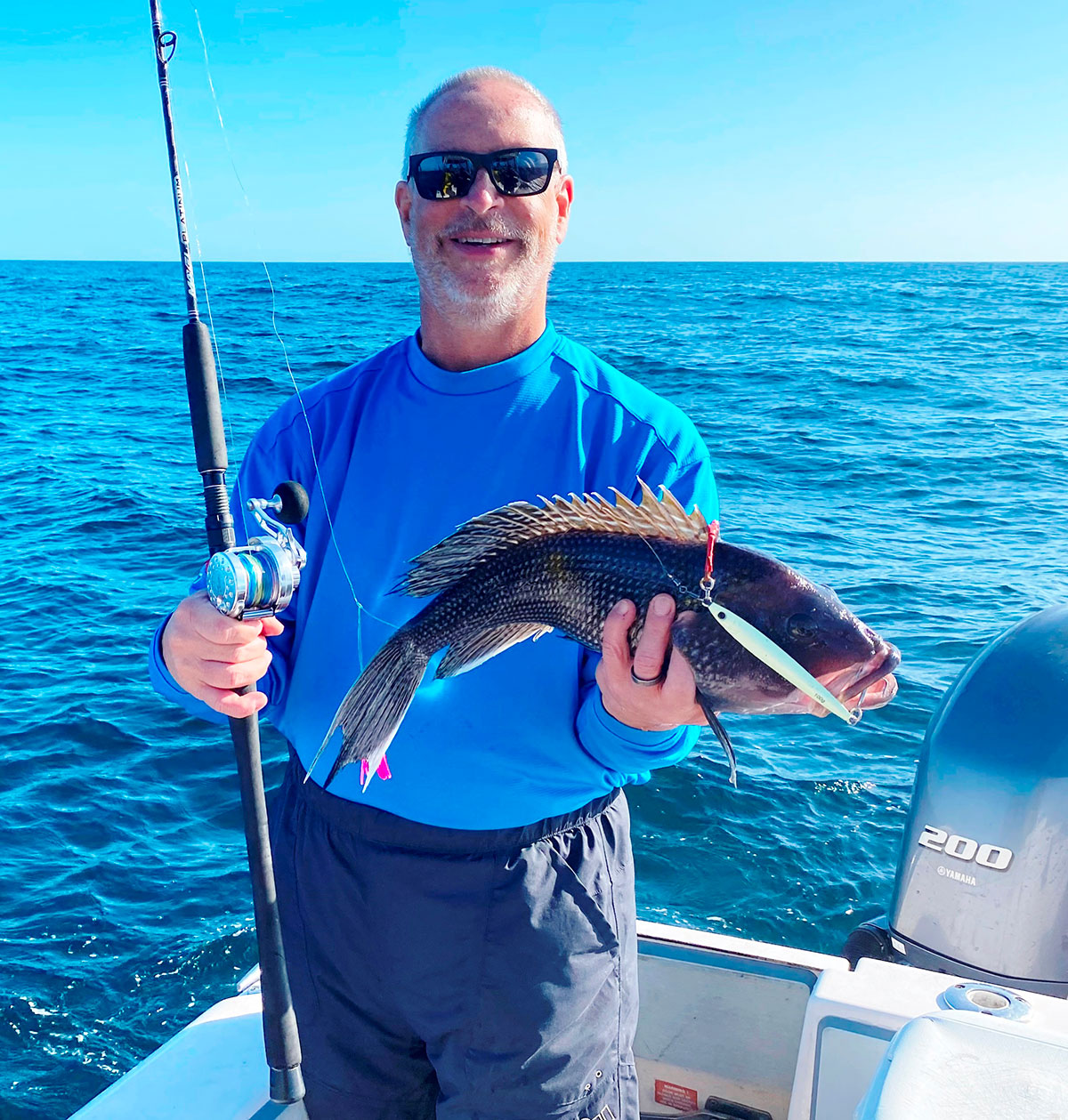
While I am still contemplating the brand, shaft length, thrust and voltage for an electric trolling motor for my EdgeWater 228 CC, I have adopted other techniques to try to keep my boat and jigs “in the zone” when working the bottom for sea bass. My go-to technique to stall my boat over a wreck, reef or rock pile is the proven “stemming the tide.” Once I determine the drift angle and the effect the wind, waves, and current have on my drift (be advised that sometimes they can be moving in the same direction and sometimes either quartering or opposite directions), I’ll do my best to creep up on the bottom structure profile that’s zoomed in on my 12-inch chart plotter display and keep her as steady as possible over the structure.
If the drift speed is typically 2 knots or less, this technique of stemming the tide works great up to depths of 120 to 130 feet of water. When working 140- to 180-foot depths, especially if I don’t want to use heavier jigs on my relatively light tackle outfits, I’ll go back to drifting, sometimes employing a drift anchor, but will set up 20 to 30 yards uptide of the wreck or bottom structure. Once the boat is in position and I’m confident that the drift will take me through the largest number of saved marks shown on my screen’s plot field for that piece of structure, I’ll have my anglers cast their jigs 15 to 20 yards downwind into the drift. If the timing is right, by the time those jigs are at the bottom, all the lines will be vertical, and we will be right in the middle of the rubble field. A few hard snaps, twitches, or gentle lifts of the rod tip will typically elicit hard strikes from hungry and aggressive sea bass. The next challenge is to get them up and out of the structure before the lines scope out and you get hung up.
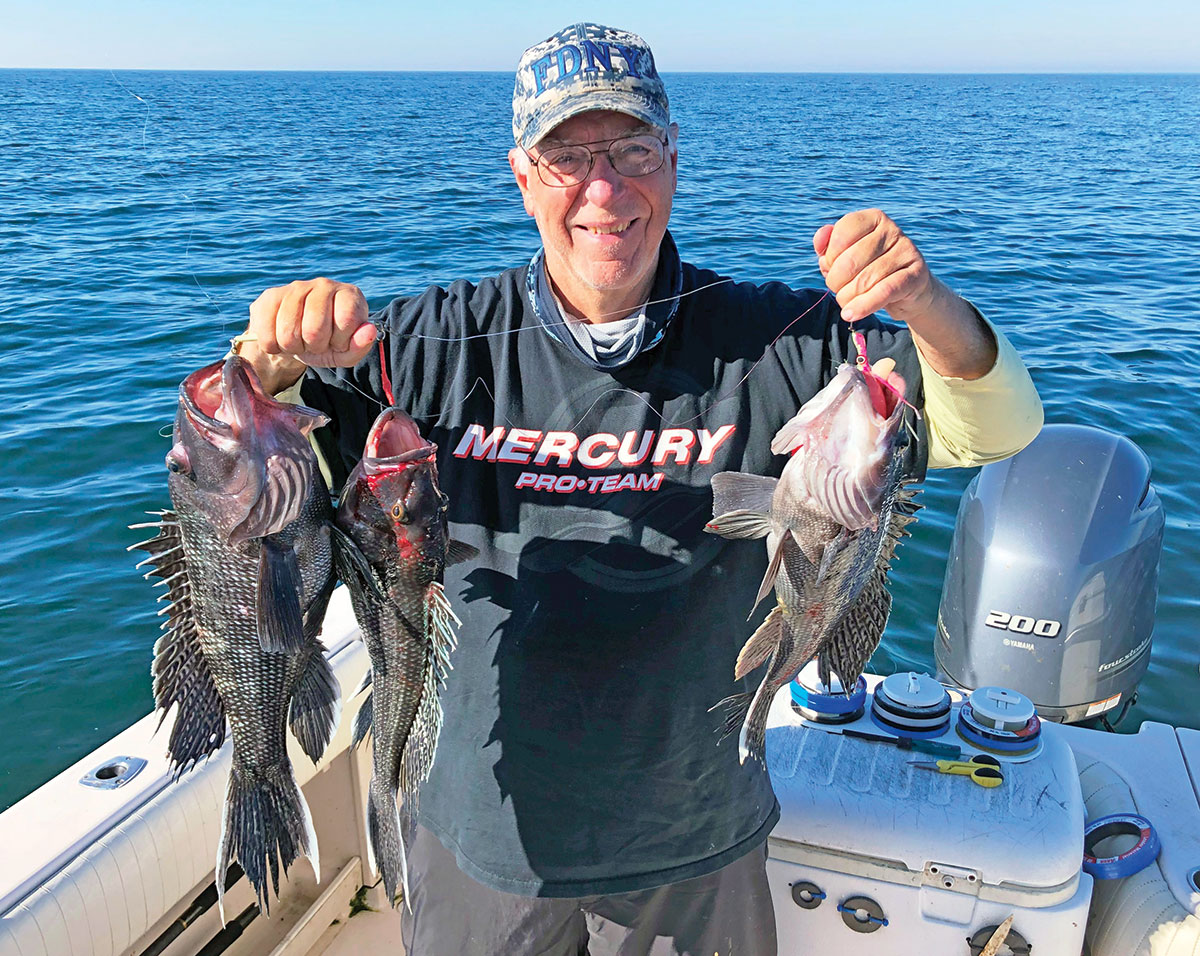
Choose Your Weapons
Decades ago, when things were different and bountiful amounts of fish seemed to be everywhere, I was a big believer in the “one size fits all” approach to catching a variety of inshore ocean species on the same rod and reel combo. Those days are long gone, and with the focus more on conservation, limited seasons, more restrictive size and bag limits, species scarcity, micro reels, braided lines, and such, I prefer to use purpose-built jigging rods when sea bass are on the menu. I am always tweaking this gear, but have gravitated towards employing a few PENN, Shimano and Maxel/Tsunami conventional and spinning outfits to enhance both the enjoyment factor and efficiency of my deep jigging efforts.
Talking with the folks at Hogy Lures, which also manufacture and distribute a lineup of casting and spinning rods for jigging and light tackle trolling, owner Capt. Mike Hogan shared some interesting thoughts about employing purpose-built jigging rods for the singular task at hand, for whatever species you seek. “Your casting gear will work acceptably for vertical jigging in a pinch, but a good dedicated jigging rod will make it easier and more enjoyable when using this technique,” Hogan told me, explaining how the very nature of vertical jigging makes selecting a rod designed for this technique a wise decision. “For example, a true vertical jigging rod is typically shorter and features a more parabolic action than a rod used for casting,” Hogan said, adding, “The shorter length allows for better control when vertical jigging since, as the name suggests, the goal is to keep in contact with your lure when it is straight below you.
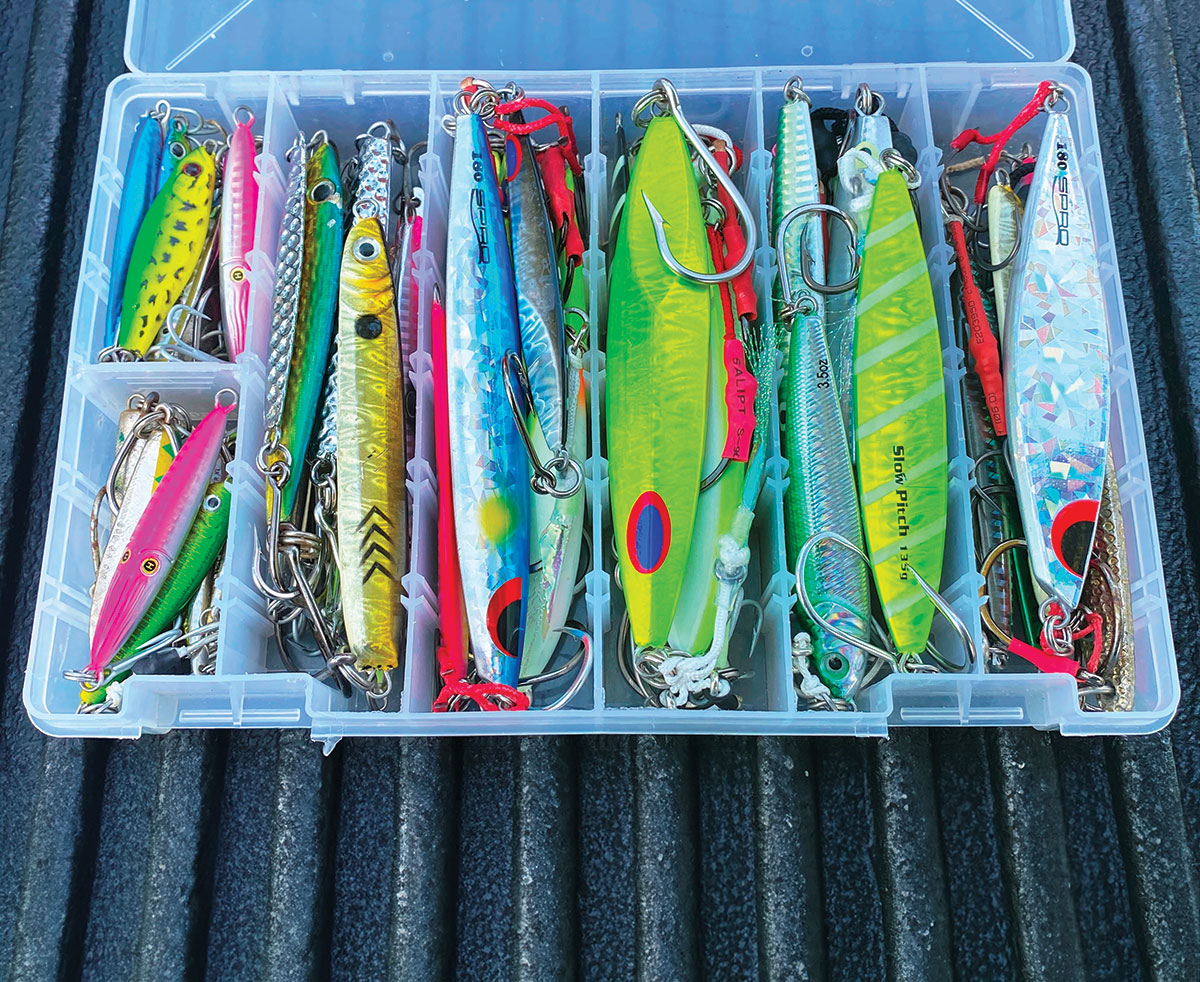
“A longer rod simply extends the distance you are away from the ideal vertical orientation, making it more cumbersome to control the jigging action and feel subtle pick-ups,” said Hogan, explaining that vertical jigging rods not only have to feature sufficient backbone or power to control and bring a fish to the surface, often from significant depths, but their more moderate, parabolic action will handle a strike better. “Rods that are too stiff or with tips that are too fast will often result in popped hooks when a fish hits a lure that is being vertically jigged,” he said, explaining how vertical jigging is often practiced in deep water, which might also feature heavy currents. “The use of 4- to 6-ounce jigs is common practice, and a shorter rod handles that weight more efficiently while also allowing an angler to scale back to lighter jigs when the current eases or slacks off,” he noted.
This is sage advice and based on my experience and the jigging rods I am currently using, 99% of them feature this type of parabolic action and are from 6 to 6-1/2feet in length for better control. The shorter length of these sticks also helps to minimize unplanned collisions with overhead obstructions that you typically find on most fishing boats like T-Top or hardtop frames, antennas, rocket launcher setups, outriggers/halyards, or whatever.
On the conventional side, I have set up dedicated 20, 30, and 40-pound jigging combos based on the depth of water, amount of line-breaking structure, current flow, jig weight range, and the size of the fish we expect to catch. These are not “you must own one of these” recommendations, just outfits that experience and opportunity have shown me to fit my current checklist of deep jigging needs.0
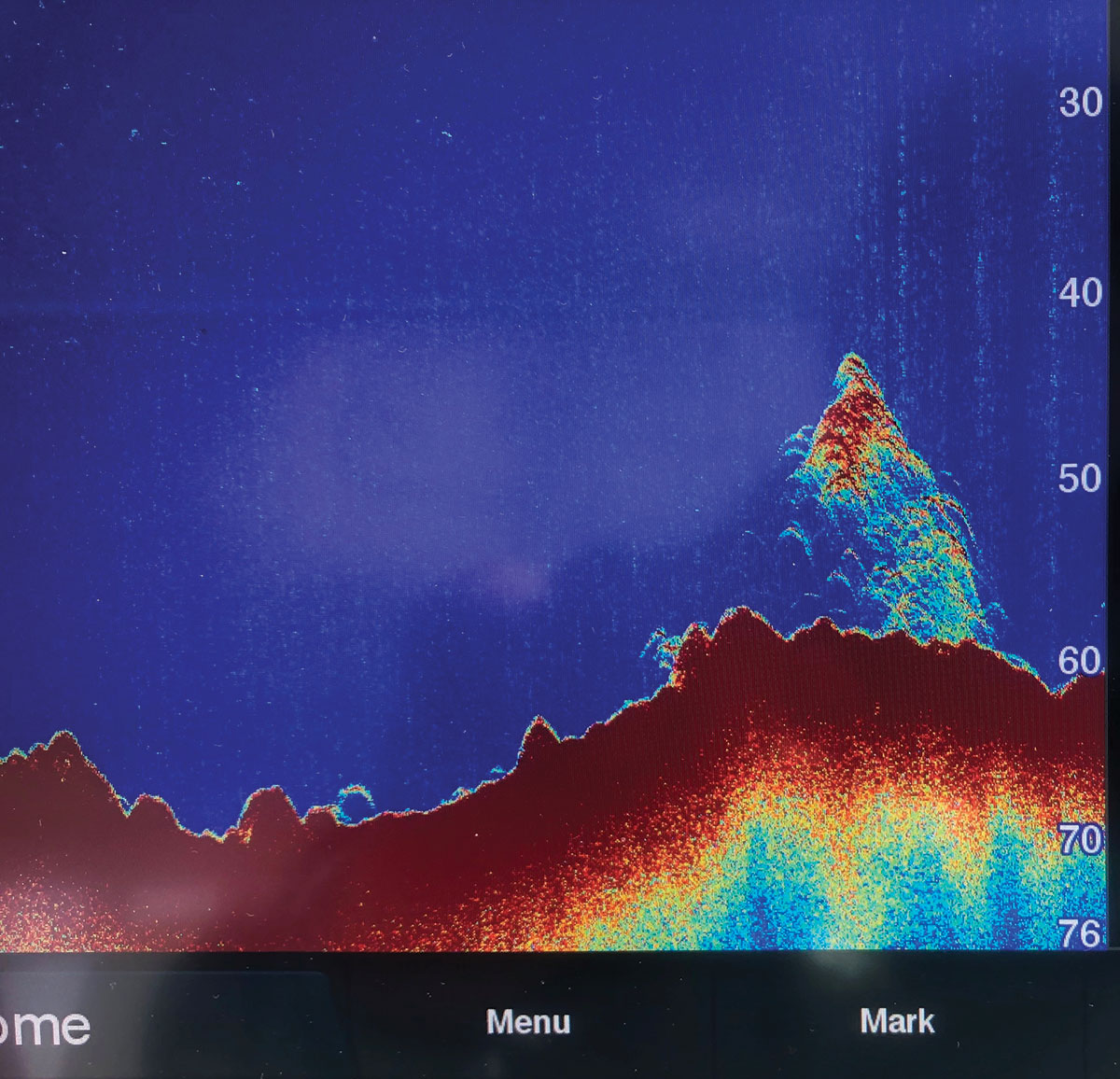
Here’s a breakdown of my current favorite four light-to-medium, conventional sea bass deep jigging outfits that also work equally well on other species that might happen to join the party on any given trip:
20-POUND
Reel: Avet SXJ Gen2 lever drag, 5.3:1 gear ratio, 18-pound max drag
Rod: 6-foot Shimano Talavera Type-J (parabolic slow pitch jig action) TTJC60MH
Rod Rating: 50-pound braid max; 250-gram jig max; medium heavy power; fast action
Line: 20-pound TUF-Line Dominat8 Superbraid (400+ yards, w/30-pound top shot)
30-POUND (#1)
Reel: Avet SX Gen2 lever drag, 5.3:1 gear ratio, 18-pound max drag
Rod: 6.-1/4-foot Ugly Stik Tiger Lite Jigging (parabolic action) USTEJG50100C631
Rod Rating: 50- to 100-pound braid; 112- to 200-gram (4- to 7-ounce) jigs
Line: 30-pound TUF-Line 4orce Superbraid (400+ yards, w/40-pound top shot)
30-POUND (#2)
Reel: Maxel Hybrid 25 star drag, 5:1 gear ratio, 28-pound max drag
Rod: 6-1/2-foot Maxel Platinum (parabolic slow pitch action) MPSPC 661MH
Special Notes- Rod was cut down one guide position to 6-feet in overall length. Tip and first three guides were replaced with larger #8 guide rings to allow for easier flow of mono/braid knot. This also stiffened tip for better control of heavier jigs.
Rod Rating: 15- to 30-pound braid; 30- to 120-gram (1- to 4-ounce) jigs
Line: 30-pound Pure Fishing SpiderWire multi-blue braid (350+ yards, w/40-pound top shot)
| SIZE & COLOR |
| When choosing the right jig weight, color and shape for deep dropping sea bass, be advised that one size does not fit all situations. Many things come into play that will affect how quickly your jig will get down to the bottom and what it will do when it gets there. The folks over at Hogy lures have developed this handy Groundfish Depth Chart guide to the optimum jig size based on the depth of water that you intend to fish. Of course, you have to temper these recommendations somewhat with the wave, current and tidal flow conditions of the day you are fishing, adding some additional weight and/or cutting back on the diameter of your line to reduce water pressure and scope to keep your jigs close to the bottom in the optimum vertical format.
|
40-POUND
Reel: Shimano SpeedMaster 8II two-speed (6.2:1/4.1:1) lever drag, 18-pound max drag
Rod: 6-foot Shimano Talavera Type-J (slow pitch parabolic action) TTJS60MH
Rod Rating: 40- to 80-pound braid; heavy power; moderate fast action
Line: 40-pound PowerPro braid (425+ yards, w/50-pound top shot)
Shifting gears over to the spinning side of the equation, here are the details for a trio of outfits that I currently use for my deepwater black sea bass jigging efforts:
15-POUND SPIN
Reel: Penn Battle III DX 4000, 6.2:1 gear ratio, 15-pound max drag
Rod: 6-foot Shimano Trevala (parabolic slow pitch jig action) TVC60HB
Rod Rating: 50-pound braid max; 250-gram jig max; medium heavy power; fast action
Line: 15-pound PowerPro braid (325+ yards, w/30-pound top shot)
20-POUND SPIN
Reel: Penn Battle III DX 4000, 6.2:1 gear ratio, 15-pound max drag
Rod: 6-1/4-foot Tsunami Sapphire XT Pro (parabolic action) SABSXTP-631M
Rod Rating: 15- to 30-pound braid; 3/4- to 4-ounce (20- to 112-gram) lures
Line: 20-pound TUF-Line 4orce (275+ yards, w/30-pound top shot)
30-POUND SPIN
Reel: Penn Battle III DX 5000, 5.6:1 gear ratio, 25-pound max drag
Rod: 6-1/2-foot Ugly Stik Tiger Lite Jigging (parabolic action) USTEJG50100S661
Rod Rating: 50- to 100-pound braid; 4- to 7-ounce (112-200gr) lures
Line: 30-pound TUF-Line Dominat8 (300 yards, w/40-pound top shot)
For superbraid, I use a mix of whatever I have available at the moment, which includes Western Filament 4orce or Domin8, Pure Fishing Spider Wire, PowerPro standard or Maxcuatro, Yo-Zuri superbraid or Daiwa X-4 J-Braid. I have an equal split of line divided either into either stealth four-color blue or single color moss green with shorter 8- to 10-foot wind-on mono or fluorocarbon leaders, or high-vis yellow line with a longer 20- to 25-foot mono/fluoro wind-on top shot.
If I’m doing a lot of flipping or casting with these outfits, I’ll typically employ a lower profile Alberto (up and down reverse Albright) knot to minimize beating up the knot on the guides. If I have to retie a braid/mono connection in 30 seconds or less to get back into a hot bite, I’ll substitute a Bristol knot, which sports a slightly bulkier profile but is the fastest, consistently reliable knot I can tie in the shortest amount of time. FG knots, SC knots, Carrot knots, uni-to-uni, etc. all have their supporters, but these are the connections that work for me.
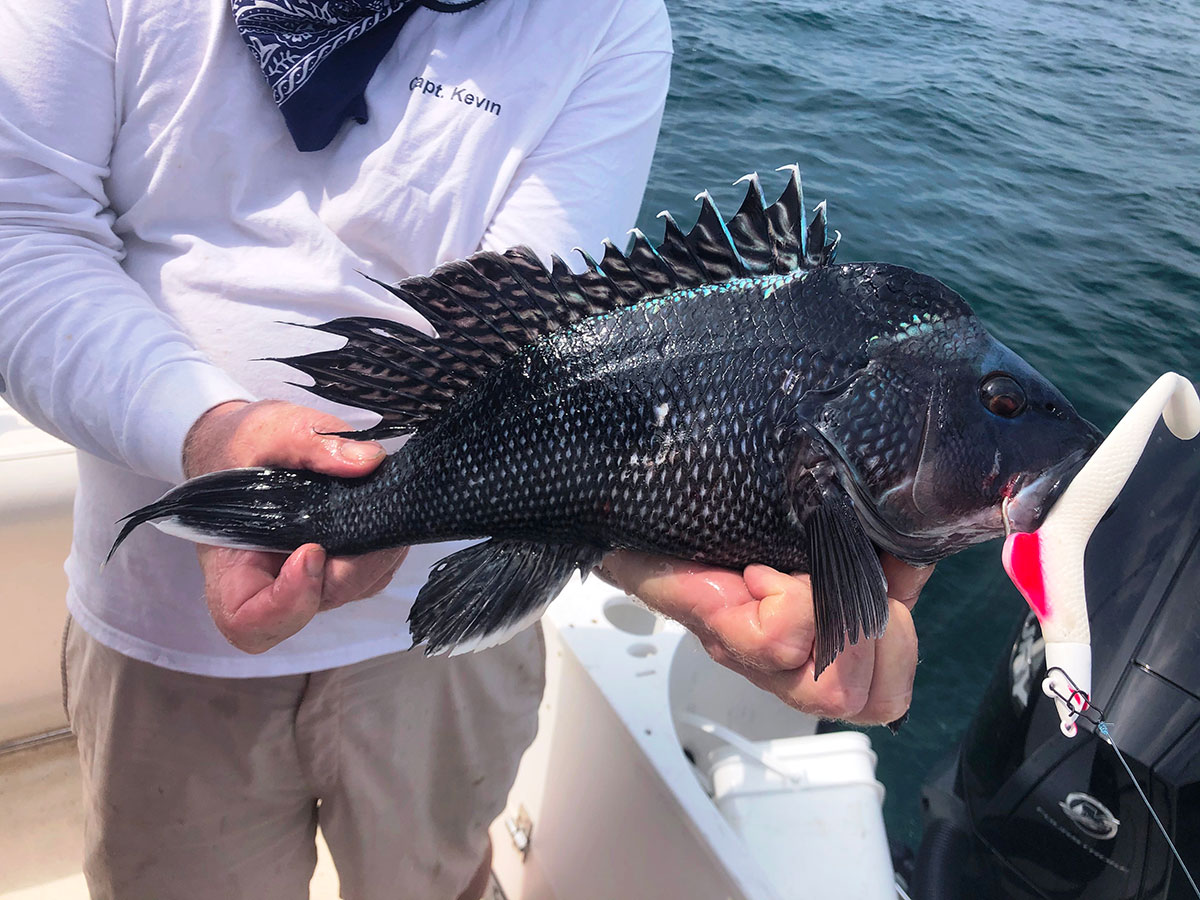
Jigs & Jigging Techniques
We could spend an entire article just on this one topic, but for the sake of brevity, I’ll summarize a variety of jigging techniques that work for me, depending on the depth, position of the fish in the water column, mood of the fish, speed of the drift, plus wind/waves/tide:
- Snap-jigging (violent 3- to 4-foot snap up once the jig hits the bottom)
- Large sweep, slow lift and drop back under tension to the bottom (length of the rod tip)
- Short sweep, slow lift and drop back to the bottom (12 to 15 inches)
- Slow retrieve up and drop back to the bottom (within 10 feet of the bottom)
- Nervous twitch on the bottom (similar to inshore fluke drifting technique)
- Nervous twitch at marked midrange depths where sea bass swarms are located
- Slow pitch jigging (pick a depth where fish are spotted on the echo sounder, drop your jig in the zone, crank up one turn while lifting up, flutter jig back under tension, repeat)
Regarding preferred jigs, my current inventory includes a minimum of a few hundred stored in myriad 3600 and 3700 series Plano tackle trays kept in milk crates, tackle bags, onboard tackle lockers, travel back packs or wherever. This stockpile features metal of all shapes, sizes and colors from over a dozen manufacturers. Some of my go-to jigs include Hogy Sand Eel, Herring and Heavy Minnow jigs, SPRO Prime Bucktail jigs, Tsunami blade jigs, plus Shimano butterfly and flat fall jigs. I will frequently change up the rigging of each metal jig, going from treble to single hooks on the bottom, assist hooks on the top, teasers ahead of the jigs, etc. until I find what works best on the day we’re fishing. Having a good set of split ring pliers onboard makes these swaps smooth and easy, as does a small box of various size split rings and assist hooks.
For me, even with close to five decades of targeting sea bass for my crews and charter fishing anglers, I’m always learning new things, tweaking my gear and field-testing new jigs and assist hook rigging. When black sea bass season opens up in your area, try to put some of these tips and tricks to work and hopefully you will be rewarded with more consistent rod-bending action and larger fish for the cooler.
